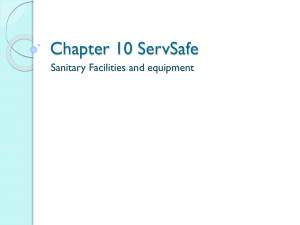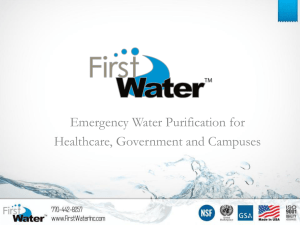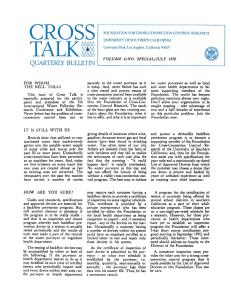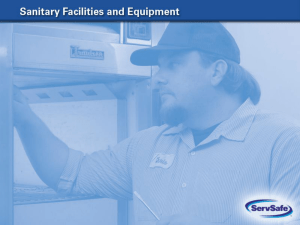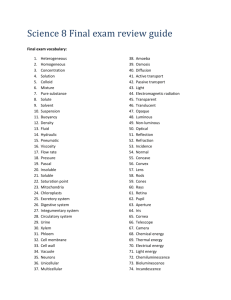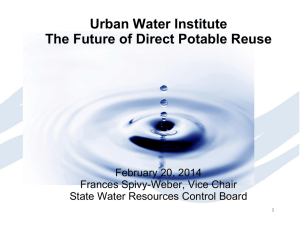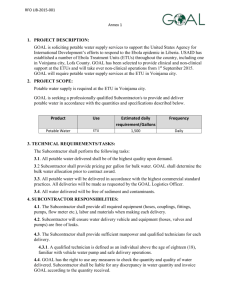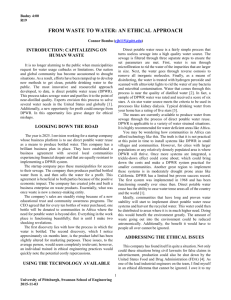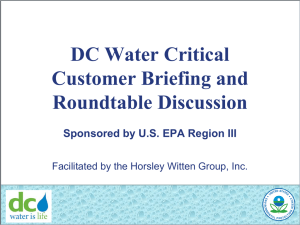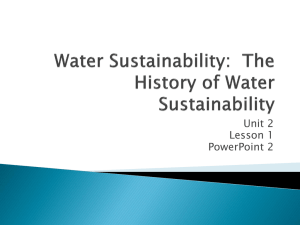Cross Connection Control Plan
advertisement
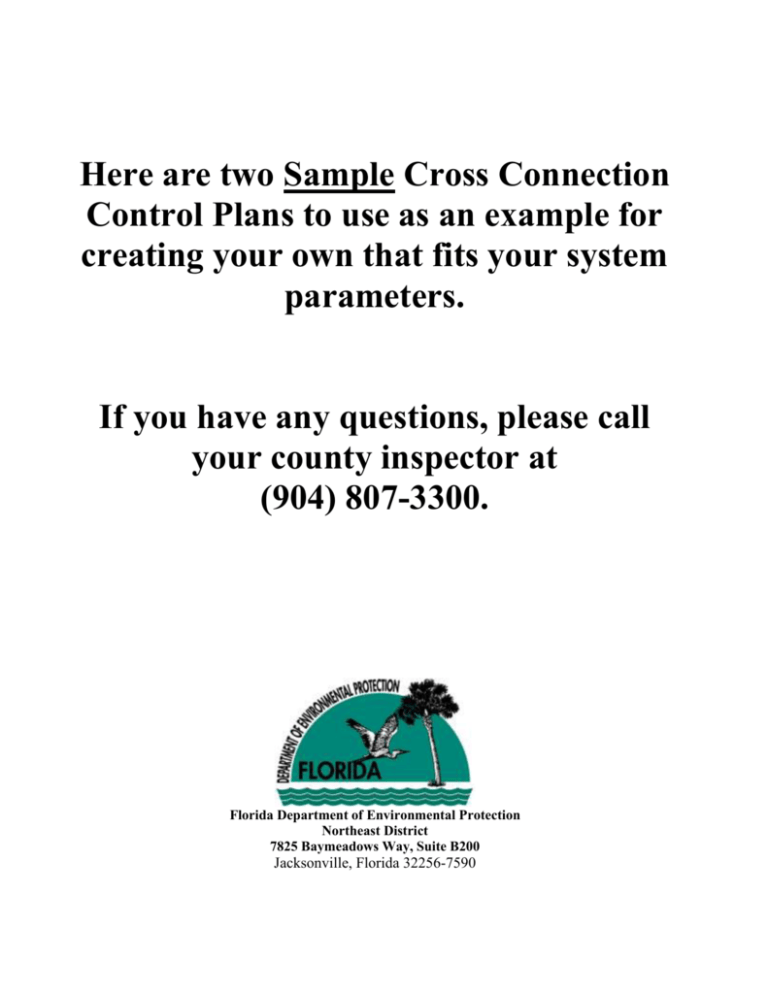
Here are two Sample Cross Connection Control Plans to use as an example for creating your own that fits your system parameters. If you have any questions, please call your county inspector at (904) 807-3300. Florida Department of Environmental Protection Northeast District 7825 Baymeadows Way, Suite B200 Jacksonville, Florida 32256-7590 Cross-Connection Control Plan Pine Crest Manor Section 1 -- Purpose The purpose of this plan is to protect the potable water supply from the possibility of contamination or pollution by isolating such contaminants or pollutants that could backflow into the potable water system; and to promote the elimination or control of existing cross connections, actual or potential, between the potable water system and nonpotable water systems and plumbing fixtures; and to provide for the maintenance of a continuing program of cross-connection control that will systematically and effectively prevent the contamination or pollution of all potable water systems. As water is transported from the treatment facility to the customer, opportunities exist for unwanted substances to contaminate it. One common means for such contamination is by backflow of nonpotable fluids through cross-connections into the potable water system. All users of the system, and workmen associated with the system, must be aware of this problem and constantly alert to any connection to the system which may allow such a cross-connection and what preventative measures can be taken to ensure a safe, potable water supply. Section 2 --Definitions Air-Gap The unobstructed vertical distance through free atmosphere between the lowest point of a water supply outlet and the flood level rim of the fixture or assembly into which the outlet discharges. These vertical, physical separations must be at least twice the diameter of the water supply outlet, but never less than 1 inch (25 mm). Approved Accepted by the authority responsible as meeting an applicable specification stated, or as suitable for the proposed use. Auxiliary Water Supply Any water supply on or available to the premises other than the approved potable water supply. These auxiliary waters may include water from another potable water supply or any natural source such as a well, spring, river, stream, harbor, etc., or “used waters” or “industrial fluids”. These waters may be polluted, or they may be objectionable and constitute an unacceptable water source over which the water purveyor does not have sanitary control. Backflow The undesirable reversal of flow in a potable water distribution system as a result of a crossconnection. Backflow Preventer An assembly or means that prohibits backflow into the potable water supply. Backpressure A pressure, higher than the supply pressure, caused by a pump, elevated tank, boiler, air/steam pressure, or any other means, which may cause backflow. CCC Plan Pinecrest Manor Page 2 of 5 Backsiphonage Backflow caused by a negative or reduced pressure in the supply piping. Backflow Preventer An assembly or means designed to prevent backflow. A. Air Gap The unobstructed vertical distance through the free atmosphere between the lowest opening from any pipe or faucet conveying water or waste to a tank, plumbing fixture, receptor, or other assembly and the flood level rim of the receptacle. These vertical, physical separations must be at least twice the diameter of the water supply outlet, never less than 1-inch. B. Reduced-Pressure Backflow-Prevention Assembly The approved reduced-pressure principle backflow-prevention assembly consists of two (2) independently acting approved check valves together with a hydraulically operating, mechanically independent pressure differential relief valve located between the check valves and below the first check valve. These units are located between two (2) tightly closing resilient-seated shutoff valves as an assembly and equipped with properly located resilient-seated test cocks. C. Double Check Valve Assembly The approved double check valve assembly consists of two (2) internally loaded check valves, either spring loaded or internally weighted, installed as a unit between two (2) tightly closing resilient-seated shutoff valves and fittings with properly located resilient-seated test cocks. This assembly shall only be used to protect against a non-health hazard (that is, a pollutant). Contamination An impairment of a potable water supply by the introduction or admission of any foreign substance that degrades the quality and creates a health hazard. Cross-Connection A connection or potential connection between any part of a potable water system and any other environment containing other substances in a manner that, under any circumstances would allow such substances to enter the potable water system. Other substances may be gases, liquids, or solids, such as chemicals, waste products, steam, water from other sources (potable or nonpotable), or any matter that may change the color or add odor to the water. Cross-Connections -- Controlled A connection between a potable water system and a nonpotable water system with an approved backflow-prevention assembly properly installed and maintained so that it will continuously afford the protection commensurate with the degree of hazard. CCC Plan Pinecrest Manor Page 3 of 5 Hazard, Degree of The term is derived from an evaluation of the potential risk to the public health and the adverse effect of the hazard upon the potable water system. A. Hazard -.Health A cross-connection or potential cross-connection involving any substance that could, if introduced into the potable water supply, cause death, illness, spread disease, or have a high probability of causing such effects. B. Hazard -Plumbing A plumbing type cross connection in a consumer's potable water system that has not been properly protected by an approved air gap or an approved backflow-prevention assembly. C. Hazard -Nonhealth A cross-connection or potential cross-connection involving any substance that generally would not be a health hazard but would constitute a nuisance or be aesthetically objectionable, if introduced into the potable water supply. D. Hazard -System An actual or potential threat of severe damage to the physical properties of the potable water system or the consumer's potable water system or of a pollution or contamination that would have a protracted effect on the quality of the potable water in the system. Industrial Fluid System Any system containing a fluid or solution that may be chemically, biologically, or otherwise contaminated or polluted in a form or concentration, such as would constitute a health, systen1, pollution, or plumbing hazard, if introduced into an approved water supply. This may include, but not be limited to: polluted or contaminated waters; all types of process waters and used waters originating from the potable water systen1 that may have deteriorated in sanitary quality; chemicals in fluid form; contaminated natural waters, such as wells, springs, streams, rivers, bays, harbors, seas, irrigation canals or systen1S, and so forth; oils, gases, caustic and acid solutions, and other liquid and gaseous fluids used in industrial or other purposes. Pollution The presence of any foreign substance in water that tends to degrade its quality so as to constitute a nonhealth hazard or impair the usefulness of the water. Service Connection The terminal end of a service connection from the potable water supply, that is, where the water purveyor loses jurisdiction and sanitary control over the water at its point of delivery to the customer's water system. There should be no unprotected takeoffs from the service line ahead of any backflow-prevention assembly located at the point of delivery to the customer's water system. CCC Plan Pinecrest Manor Page 4 of 5 Water -Nonpotable Water that is not safe for human consumption or that is of questionable quality. Water -Potable Water that is safe for human consumption as described by the public health authority having jurisdiction. Water Purveyor Owner of the source facilities, treatment facilities, and the distribution system providing potable water to customers. Water-Used Any water supplied by a water purveyor from a potable water system to a consumer's water system after it has passed through the point of delivery and is no longer under the sanitary control of the water purveyor. Section 3 – Policy A. No water service connection shall be installed or maintained by the water purveyor unless the water supply is protected as required by the Florida Department of Environmental Protection and state/provincial laws and regulations. Service of water to any customer shall be discontinued by the water purveyor if a required backflow-prevention assembly is not installed, tested, and maintained, or if it is found that a backflow-prevention assembly has been removed, bypassed, or if an unprotected cross connection exists. Service will not be restored until such conditions or defects are corrected. B. Both the water purveyor's system and any customer's system shall be open for inspection at all reasonable times to authorized representatives of the Florida Department of Environmental Protection to determine whether cross-connections or other structural or sanitary hazards exist. When such a condition becomes known, the water purveyor shall deny or immediately discontinue service to the customer by providing for a physical break in the service line until the customer has corrected the condition in conformance with state/provincial and city statutes relating to plumbing and water supplies. C. Backflow-prevention devices shall be specified in accordance with the American Water Works Association (AWWA) Manual of Water Supply Practices, Recommended Practice for backflow Prevention and Cross-Connection Control (AWWA M14), current version, the Foundation for Cross Connection Control and Hydraulic Research (FCC & HR) at the University of Southern California, and other nationally recognized standards setting agencies. CCC Plan Pinecrest Manor Page 5 of 5 D. Any backflow-prevention assembly required by the Florida Department of Environmental Protection or state/provincial -laws and regulations shall be a model and size approved by the Florida Department of Environmental Protection. The term "approved backflow-prevention assembly" shall mean an assembly that has been manufactured in full conformance with the standards established by the American Water Works Association and has met completely the required laboratory and field performance specifications. E. It shall be the duty of the water purveyor to have certified inspection and operational tests made at least once per year for any backflow-prevention assemblies on the water purveyor's property. These inspections and tests shall be made at the expense of the water purveyor and shall be performed by a certified tester approved by the Florida Department of Environmental Protection. These assemblies shall be repaired, overhauled, or replaced at the expense of the water purveyor whenever said assemblies are found to be defective. Records of such tests, repairs, and overhaul shall be kept on file and shall be submitted to the Florida Department of Environmental Protection. F. It shall be the duty of any customer utilizing potable water from the water purveyor who has backflow-prevention assemblies installed within their property to have certified inspections and operational tests made at least once per year. These inspections and tests shall be made at the expense of the customer and shall be performed by a certified tester approved by the Florida Department of Environmental Protection. These assemblies shall be repaired, overhauled, or replaced at the expense of the customer whenever said assemblies are found to be defective. Records of such tests, repairs, and overhaul shall be kept on file and shall be submitted to the water purveyor. Silver Dolphin MHP Cross-Connection Control Plan Introduction The purpose of this plan is to eliminate, insofar as possible, any arrangement of pipes, fittings, fixtures, or devices that connects a non-potable water source to the public water supply system at Silver Dolphin MHP. This is to be accomplished by alerting each water system customer to the problems which may be caused by cross-connections and through periodic inspections by the water system operator. As water is transported from the treatment facility to the customer, opportunities exist for unwanted substances to contaminate it. One common means for such contamination is by back flow of non-potable fluids through cross-connections into the potable water system. All users of the system, and workmen associated with the system, must be aware of this problem and constantly alert to any connection to the system which may allow such a cross-connection and what preventative measures can be taken to ensure a safe, potable water supply. Water System Customer Each customer as a condition to connection to the system, shall allow access to the property by the water system owner’s representative for purposes of locating any possible or potential crossconnection. Water System Owner The water system owner shall be responsible to hire qualified operators to operate and maintain the system. Each employee shall be familiar with this plan and shall be familiar with potential areas where cross-connections may occur and preventative measures that may be taken to avoid contamination of the system. The owner shall install a hose bib vacuum breaker on the faucet, supplying all trailers within one year. The owner shall provide qualified personnel to survey the area on a periodic basis for potential cross-connections. Water System Employees All employees, operators of the water system shall read this plan and provide assurance to the owner that he has an understanding of cross-connection prevention. All employees of the water system shall be sensitive to cross-connection control. Meter readers and system operators shall be on the alert for potential cross connections at all times. The system operator will survey the system during each month of the year for the specific purpose of locating cross-connections or potential cross-connections. Reporting Cross-Connections Anyone observing a cross connection or potential cross-connection in Silver Dolphin MHP Water System shall first point out the problem and discuss the significance with the customer. He shall then report the occurrence to the owner of the water system in writing. The licensed operator shall be responsible for assuring that all cross-connections or potential cross connections are corrected.
